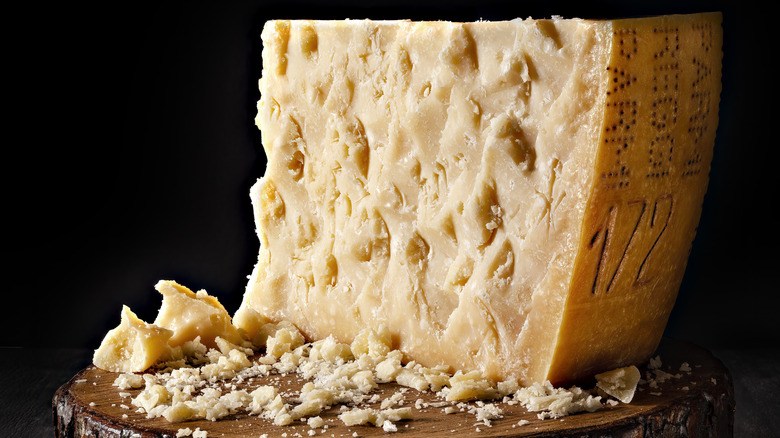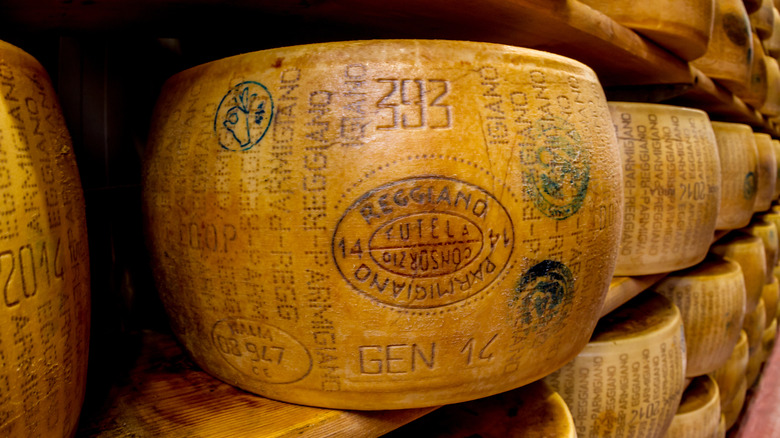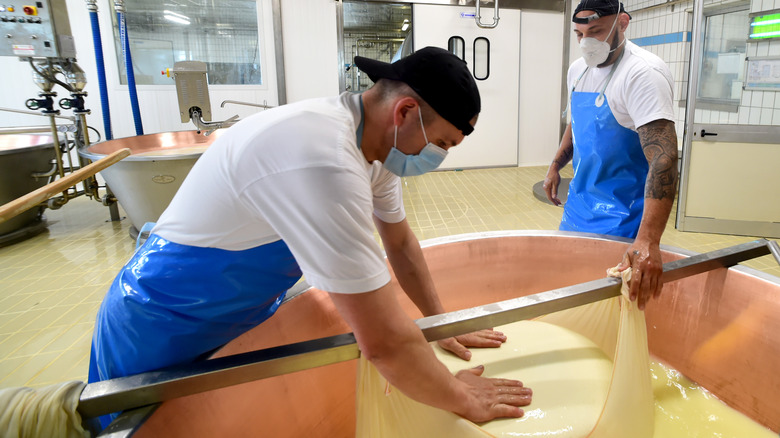Parmigiano Reggiano's Origins Began With Monks In The Middle Ages
It is estimated that over 1,800 varieties of cheese exist around the globe. So, to be labeled as, "the undisputed king of cheeses" is a pretty impressive feat. Now, such a label is very subjective; one man's "king" could be Colby while another prefers French Camembert. But those savvy in the food world tend to think one specific cheese is worthy of the title: Parmigiano Reggiano.
Beloved all over the world, this Italian delicacy has been made for almost a thousand years under very strict and specific regulations. It is made of only three ingredients: cow's milk, salt, and rennet (a natural enzyme that aids in the milk curdling), yet, the resulting flavor and texture are unrivaled.
Parmigiano Reggiano has a dry, crumbly texture with characteristic crunchy granules spread throughout. It is sharp, but not overly so; if anything, the taste is described as classic umami, with mild salt, nuttiness, and a subtle fruitiness. And it tastes good with just about everything, whether it's drizzled with aged balsamic, shaved over pasta, or sprinkled over soups.
So, what genius thought up this monumental cheese that has withstood the test of time? It wasn't a scientist, royal chef, or brilliant farmer, but monks. Amazingly, the same process they used in the Middle Ages is still used today.
An age-old tradition
The first written evidence of Parmigiano Reggiano cheese dates back to 1254 in the form of a deed written in Genoa, Italy. It can be deduced, then, that the cheese was being produced shortly before this time. Benedictine and Cistercian monks from the Emilia Romagna region of Italy had been trying to develop a cheese that would stay safely edible for long periods of time.
Remember, this was the Middle Ages when food shortages were common, and preserving food wasn't as easy as it is today. Working with salt from the nearby Salsomaggiore salt mines and the milk from their monasteries' farm cows, the monks created what we know today as Parmigiano Reggiano.
Religious monks may have lived humbly and frugally, but they also were one of the more educated and privileged groups in society. They could read, had access to documents and manuscripts, and were educated in things like farming, medicine, and, yes, even cheese-making. By the 14th century, the cheese was being traded in various Italian regions and by the 16th century, it was being shipped to other European countries.
This was possible, in part, because Parmigiano Reggiano didn't need refrigeration and could travel long distances without spoiling. Today, of course, it is available worldwide, but in order to be labeled as "Parmigiano Reggiano," many strict standards must be met.
If it's not broken, don't fix it
The milk must come from closely monitored cows that are flawlessly raised in the Parma, Reggio Emilia, Modena, and parts of Mantua and Bologna regions. Their fresh milk, salt, and rennet are heated in copper vats until curds are formed. These curds are cooked until they become one large mass which is split and formed into two giant wheels. From here, the wheels are submerged in saltwater brine, removed, and aged for at least 12 months. After much testing and quality control, the wheels can be designated as authentic.
For centuries, people have been imitating the creation of Parmigiano Reggiano and selling their wares as authentic, so in 1612 the first Denomination of Origin was created by the Duke of Parma, which established rules and laws that producers had to follow in order for their cheeses to be deemed authentic. It wasn't until 1992 that Parmigiano Reggiano obtained security from the continent of Europe itself. Needless to say, this piece of tradition is fiercely protected.
Today, Parmigiano Reggiano is not produced by monks or monasteries, but by a little over 300 dairies, all located in the Emilia Romagna province of Italy. It is one of the more expensive cheeses on the market, but considering the pristine production and rich history that goes into every 80-pound wheel, many would agree that it's worth every penny. Plus, it's not going to go bad in your fridge any time soon.


